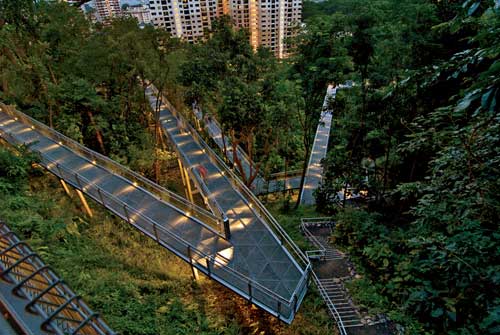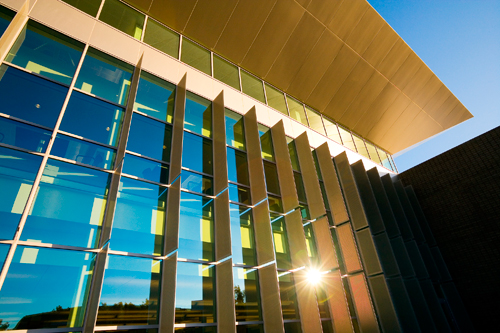A Light Touch Enhances Sustainable Design
"Tread lightly upon this earth, seeing, understanding, but never imposing."
Though this quote may be used for Zen inspiration, it's a fitting gesture toward the intentions of sustainable design. At its core, green architecture is about achieving programmatic goals and building aesthetics without sacrificing resources that can be utilized by designers in the future. From a construction standpoint, then, it would make sense that the most efficient approach preserves a maximum amount of the site, so that natural conditions can continue to exist for future generations.
designers in the future. From a construction standpoint, then, it would make sense that the most efficient approach preserves a maximum amount of the site, so that natural conditions can continue to exist for future generations.
One fantastic project in Singapore's Blangah Hill Park takes this mindset to new heights--literally--with a lofty walking trail that floats through a forest park, snaking a light, airy pathway through the trees with minimal impact on the ground below. Called Forest Walk, this ethereal project goes out of its way to wind around trees, rather than over or through them (which would result in their being cut down), and uses light materials and a kit-of-parts construction to leave the site below relatively undisturbed. Triangulated grating, tied together by steel beams, are supported on slender six or eight inch columns which rest on small concrete footings anchored into the ground with micro-piles. Combined with the desire to keep the entire path sloped at a maximum of 1:12 for accessibility despite the often drastically undulating terrain below, this scheme results in an incredible experience that allows visitors to walk among the trees, meandering along with forest canopy at a height that allows for a unique angle of observation of plants and animals, not to mention the surreal feeling of being freed from the constraints of gravity. Soaring as high as 60 feet above the ground and zigzagging back and forth between trees, this flighty trail provides a very tangible execution of the "tread lightly" mantra.
--
 Although LPA may not receive exotic and spectacular sites such as Singapore's wilderness park, we employ similar concepts in much of our site and master planning when studying the best design methods in our projects. School campus buildings are often clustered closer together to minimize branching of underground infrastructure and maximize open space. Site grading is simplified in an attempt to disturb the least amount of land. Existing landscape amenities, like mature trees and water flow channels, are preserved wherever possible in order to maintain status quo in the local environment. While this may not result in otherworldly buildings hovering on stilts within a lush blanket of nature, it does minimize the amount of physical change to the terrain, lessening the extent of ground construction. In short, within reasonable constraints, these actions tread as lightly as possible upon what is already there, so that existing resources are retained for the future.
Although LPA may not receive exotic and spectacular sites such as Singapore's wilderness park, we employ similar concepts in much of our site and master planning when studying the best design methods in our projects. School campus buildings are often clustered closer together to minimize branching of underground infrastructure and maximize open space. Site grading is simplified in an attempt to disturb the least amount of land. Existing landscape amenities, like mature trees and water flow channels, are preserved wherever possible in order to maintain status quo in the local environment. While this may not result in otherworldly buildings hovering on stilts within a lush blanket of nature, it does minimize the amount of physical change to the terrain, lessening the extent of ground construction. In short, within reasonable constraints, these actions tread as lightly as possible upon what is already there, so that existing resources are retained for the future.
Such an attitude plays a key role within the overall structure of sustainable design and is part of what drives green architecture's mission to promote synergy between natural and built environments.
Though this quote may be used for Zen inspiration, it's a fitting gesture toward the intentions of sustainable design. At its core, green architecture is about achieving programmatic goals and building aesthetics without sacrificing resources that can be utilized by
 designers in the future. From a construction standpoint, then, it would make sense that the most efficient approach preserves a maximum amount of the site, so that natural conditions can continue to exist for future generations.
designers in the future. From a construction standpoint, then, it would make sense that the most efficient approach preserves a maximum amount of the site, so that natural conditions can continue to exist for future generations.One fantastic project in Singapore's Blangah Hill Park takes this mindset to new heights--literally--with a lofty walking trail that floats through a forest park, snaking a light, airy pathway through the trees with minimal impact on the ground below. Called Forest Walk, this ethereal project goes out of its way to wind around trees, rather than over or through them (which would result in their being cut down), and uses light materials and a kit-of-parts construction to leave the site below relatively undisturbed. Triangulated grating, tied together by steel beams, are supported on slender six or eight inch columns which rest on small concrete footings anchored into the ground with micro-piles. Combined with the desire to keep the entire path sloped at a maximum of 1:12 for accessibility despite the often drastically undulating terrain below, this scheme results in an incredible experience that allows visitors to walk among the trees, meandering along with forest canopy at a height that allows for a unique angle of observation of plants and animals, not to mention the surreal feeling of being freed from the constraints of gravity. Soaring as high as 60 feet above the ground and zigzagging back and forth between trees, this flighty trail provides a very tangible execution of the "tread lightly" mantra.
--
 Although LPA may not receive exotic and spectacular sites such as Singapore's wilderness park, we employ similar concepts in much of our site and master planning when studying the best design methods in our projects. School campus buildings are often clustered closer together to minimize branching of underground infrastructure and maximize open space. Site grading is simplified in an attempt to disturb the least amount of land. Existing landscape amenities, like mature trees and water flow channels, are preserved wherever possible in order to maintain status quo in the local environment. While this may not result in otherworldly buildings hovering on stilts within a lush blanket of nature, it does minimize the amount of physical change to the terrain, lessening the extent of ground construction. In short, within reasonable constraints, these actions tread as lightly as possible upon what is already there, so that existing resources are retained for the future.
Although LPA may not receive exotic and spectacular sites such as Singapore's wilderness park, we employ similar concepts in much of our site and master planning when studying the best design methods in our projects. School campus buildings are often clustered closer together to minimize branching of underground infrastructure and maximize open space. Site grading is simplified in an attempt to disturb the least amount of land. Existing landscape amenities, like mature trees and water flow channels, are preserved wherever possible in order to maintain status quo in the local environment. While this may not result in otherworldly buildings hovering on stilts within a lush blanket of nature, it does minimize the amount of physical change to the terrain, lessening the extent of ground construction. In short, within reasonable constraints, these actions tread as lightly as possible upon what is already there, so that existing resources are retained for the future. Such an attitude plays a key role within the overall structure of sustainable design and is part of what drives green architecture's mission to promote synergy between natural and built environments.